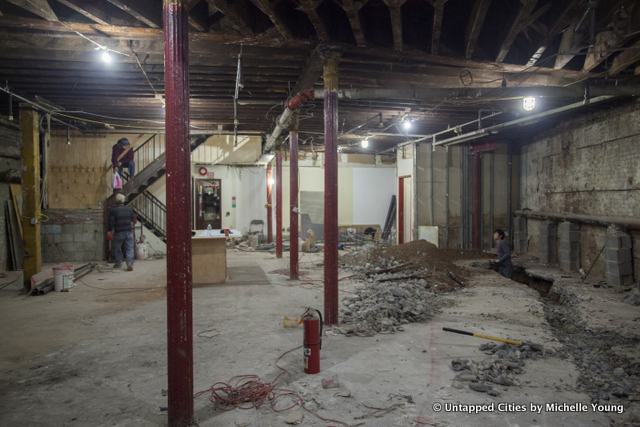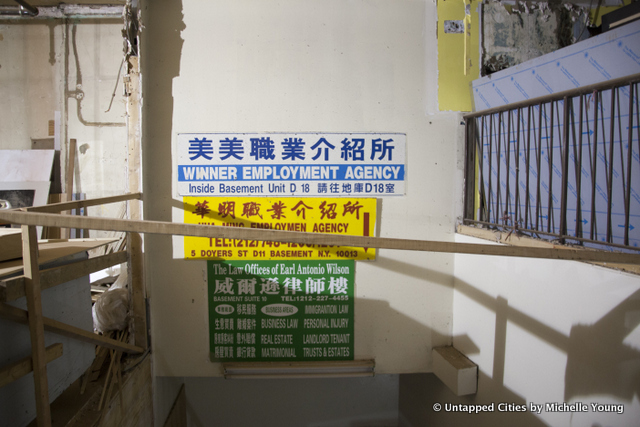 5-7 Doyers Street when it was the Chinese Theatre/Chinese Opera House. Photo from Wikimedia Commons by Bain News Service.
5-7 Doyers Street when it was the Chinese Theatre/Chinese Opera House. Photo from Wikimedia Commons by Bain News Service.
Behind a storefront at 5-7 Doyers Street in Chinatown that long concealed a mahjong den and a famed tunnel that stretched to Chatham Square, will emerge a two-floor restaurant, the Chinese Tuxedo, named for the historic restaurant that once stood just down the street. While the original location on the Bowery has been remade, rather indelicately into a Chase bank, the new Chinese Tuxedo aims to restore to public view the rich, cataclysmic history that has made Chinatown what is today.
 Slide photograph of the Chinese Tuxedo at the corner of Doyers Street and the Bowery. Photograph of slide belonging to Chu Enterprises taken by Michelle Young.
Slide photograph of the Chinese Tuxedo at the corner of Doyers Street and the Bowery. Photograph of slide belonging to Chu Enterprises taken by Michelle Young.
The development is one of several under Chu Enterprises, a three generation family business with a long history in Chinatown and what could be described as a mission for keeping the neighborhood relevant for the 21st century. The overarching question: how to transform a shrinking, culturally contained community into a thriving, growing one that the descendants of the area’s original immigrants might find desirable to live and find conducive to modern business.
 Slide photograph of the Chinese Tuxedo. Photograph of slide belonging to Chu Enterprises taken by Michelle Young.
Slide photograph of the Chinese Tuxedo. Photograph of slide belonging to Chu Enterprises taken by Michelle Young.
History is one of their strategies, as seen in what’s to come at the Chinese Tuxedo, the restaurant venture headed by Jeff Lam and mixologist Eddy Buckingham, who is behind The Liberty near Herald Square. The space at 5-7 Doyers Street was formerly the Chinese Theater (also known as the Chinese Opera House) opened by Chinatown merchant Chu Fong in 1893. In its heyday, the theater was not only an important social gathering place for the community, but also a destination for non-Chinese to show the breadth of their cultural knowledge. When it opened, the theater was the first Chinese language theater in New York City and the only Chinese theater east of California.
 Doyers Street today
Doyers Street today
It was also the site of one of the most notorious instances of tong (gang) violence, made infamous from a 1905 massacre inside the theater. Considered a neutral ground in the Chinatown organized crime world, the Chinese Theater was the scene of an unexpected shootout during a performance of The King’s Daughter, with four members of the On Leong tong killed. The attack was thought to have been coordinated by the notorious Mock Duck, a modern, Westernized Chinese transplant from San Francisco who was fearlessly wreaking havoc on long-established patterns of organized crime in Chinatown, and benefiting handsomely financially.
 The Bloody Angle of Doyers Street today, dotted with bar and restaurants like Apotheke, Pulqueria, Nom Wah Tea Parlor and soon Chinese Tuxedo
The Bloody Angle of Doyers Street today, dotted with bar and restaurants like Apotheke, Pulqueria, Nom Wah Tea Parlor and soon Chinese Tuxedo
Despite the neutrality of the Chinese Theatre, Doyers Street itself was a notoriously dangerous place to be, nicknamed the Bloody Angle. As the New York Times writes, law enforcement officials reported in 1994, “more people have died violently at Bloody Angle, the crook at Doyer Street near Pell, than at any other intersection in America.”
And as so vividly described in the book Automats, Taxidances & Vaudeville by David Freeland, the activity of the Chinese Theater at 5-7 Doyers Street influenced the layout of the underground levels below to this day. As Freeland writes, owner Chu Fong “housed the theater’s own company of performers in one of several sub-basements, musicians together in one large and actors in a warren of cubicles that had been carved out of another room. Spillover talent, actors with families, and visiting performers from China or San Francisco were often put up at the boardinghouse at 10 Chatham Square, which became a kind of adjunct space to the theater itself, connected via a passageway that curved and twisted underneath the block.”
 Underground Arcade under Doyers Street
Underground Arcade under Doyers Street
This underground tunnel also helped the actor Ah Foon, an On Leong gang member, escape after a performance to the Chatham Square boarding house, where his attackers still managed to kill him overnight when he walked out on a landing to get a drink of water. Later, this sprawling passageway was turned into an underground business arcade, filled with small offices, feng shui shops, employment agencies, travel agencies, law firms, and the like.
 This rolling door that separates the active part of the underground arcade and what will be the lower level of the forthcoming Chinese Tuxedo will be retained
This rolling door that separates the active part of the underground arcade and what will be the lower level of the forthcoming Chinese Tuxedo will be retained
Today, the historical connection between 5-7 Doyers Street and Chatham Square is now severed because the Chinese Theater is being completely renovated into the Chinese Tuxedo. But attention is being paid both to the historical elements found on both levels, including cinder blocked egresses formerly used as escape tunnels, large hinged doors, delicate columns, and iron parts that once held pipes. This means that when the new Chinese Tuxedo does open in the second quarter of this year, patrons to the restaurant will be able to see these architectural details for the first time in perhaps a century.
 The lower level, which once housed numerous small businesses in the underground arcade, under renovation
The lower level, which once housed numerous small businesses in the underground arcade, under renovation
The two floor restaurant will have a sunken dining room, with a capacity of 120 seated guests, and a 14-foot ceiling. The basement level has a similar ceiling height. Buckingham tells us, by phone interview, that the historical nature and the atypical form of the building “is what has really drawn us to the space there. The building [renovation] has proven complex, but we knew we would have a complex proposition here. The history, the charming block, the space on that scale in this neighborhood where we can retain original elements. That just doesn’t exist.”

The Chinese Tuxedo will reintroduce traditional Cantonese food to Chinatown, differentiated from the fare typically associated with the neighborhood. It will be “Cantonese with exceptional produce quality, ” says Buckingham, as differentiated from the saucy, hot, sodium laden fare. “For many people, their association with Chinatown Chinese [food] does not necessarily go hand in hand with great quality and great quality produce which is a shame.” Buckingham was born in Singapore and grew up in Melbourne, where he was surrounded by what he calls “spectacular” East Asian and Cantonese cuisine. Lam, whose office is in Chinatown, served as the general contractor for The Liberty, and the two men found a natural bond over the area’s food that became the impetus behind the Chinese Tuxedo.

Buckingham and Lam have gone as far to source historical menus from Chinatown venue spaces, (though they could not locate anything preserved from the original Chinese Theater), but found that the fare was not particularly applicable to today’s tastes. Still, Buckingham makes clear that this will not be a fusion restaurant, but rather, traditional Cantonese for the contemporary palate.

Part of the work in renovating the Chinese Theater involves making the building up to fire code, but the team is not going the easy route. Buckingham is committed to the preservation of the historic details, telling us, “We don’t want stairwells going over original tunnels. I want the decorative elements of the columns, I want those exposed. Typically you just box them out as fireproof sheet rock but there are creative solutions to all of these things.”
 Hooks used for previous pipes
Hooks used for previous pipes
When Chinese Tuxedo opens, it will be open seven days a week and the restaurant was granted a permit to operate until 1 am. Evening service will begin first, followed later by dim sum on weekends. Check out more photos below from the current build and stay tuned for more updates on this space as 2016 rolls on.
 The upper level, main floor of the future restaurant
The upper level, main floor of the future restaurant
 The upper level, main floor of the future restaurant
The upper level, main floor of the future restaurant
 Original columns
Original columns

 Remnants of the former arcade
Remnants of the former arcade
Next, check out the Doyers Street Tunnel, in its previous form and discover 5 Chinatown Alleys and Small Streets. Get in touch with the author @untappedmich.





